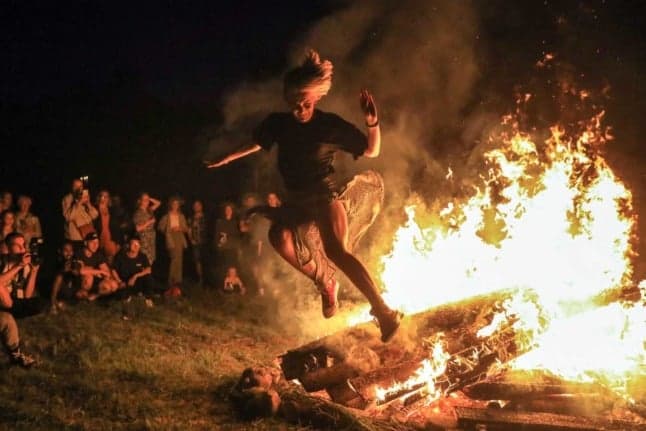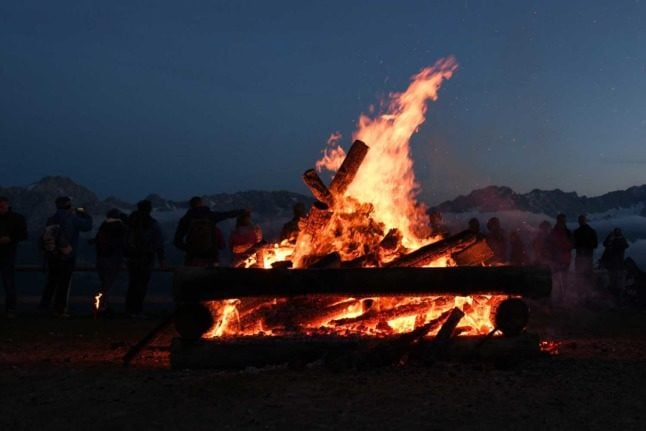Austria's Sonnwendfeuer: What is it and why is it celebrated?

Life is a bit different in the Austrian mountains but a good way to embrace the local culture is to get involved with traditional celebrations, like Sonnwendfeuer – a special annual event to mark the summer solstice.
Sonnwendfeuer (which means “fire of the solstice” in English) usually takes place on 21 June to celebrate the longest day of the year and involves lighting hundreds of fires along the mountain peaks to create a midsummer bonfire.
It’s a long tradition in Tyrol, dating back to Medieval times and, as with most long-held traditions, comes with its own myths and superstitions.
Where does Sonnwendfeuer come from?
The custom of Sonnwendfeuer started in the 14th Century and originally marked the beginning of the harvest. It involved a community celebration with drinks and bonfires.
The fires were believed to increase the power of the sun and keep evil away from people and animals.
In Medieval times, it was also believed that Sonnwendfeuer would ward off storms and make the grass on the meadows grow strong.
The Alps are inhabited by long-standing farming families, so these superstitions stem from the priorities and lifestyles of people living in the mountains during that time.
Over the years though, the meaning of Sonnwendfeuer has shifted and the fires are no longer associated with farming and the harvest. Instead, the focus is mainly on the solstice.
What happens at Sonnwendfeuer?
Basically, Sonnwendfeuer is a big bonfire event – similar to the British Bonfire Night on 5th November to mark the failed Guy Fawkes plot to blow up the Houses of Parliament.
Except the Austrian version has more mystical connotations and the event typically enjoys better weather as it takes place in the summertime.
Sonnwendfeuer starts with mountain rescue associations and groups hiking up the mountains to set the bonfires.

A similar celebration to Austria's Sonnwendfeuer taking place in southern Germany. Angelika Warmuth / dpa / AFP
Then, on the evening of Sonnwendfeuer, many families hike up to look-out points for panoramic views as the fires are lit. Or people gather in mountain towns and villages to watch.
Not all of the fires are simple bonfires though. Some are set in different signs and symbols, like hearts and crosses.
One of the most recognisable motifs is the Sacred Heart fire.
This represents the 1796 Tyrolean unity in the fight against France and Bavaria, when mountain fires were lit across the region as a symbol of the agreement, known as the Sacred Heart Oath.
How is Sonnwendfeuer celebrated today?
Today, Sonnwendfeuer, also known as “Feuerbrennen” or “Johannesfeuer”, is a family-friendly event in the Austrian Alps and Bavaria in Germany.
In smaller communities, locals gather in groups to light fires on the mountains and have drinks, but there are also more formal events organised by tourism boards.
This year, some Sonnwendfeuer events are taking place in towns and cities across Tyrol on Saturday 19 June, although there are disclaimers that events could be cancelled unexpectedly as a result of the pandemic.
In Innsbruck, the midsummer celebrations are taking place on the Innsbrucker Nordkette with the gondola running every half an hour from 6pm to take people up the mountain.
In St. Johann, a well-known viewing spot is Harschbichl station on the Kitzbüheler Horn, which is 1,700 metres above sea level.
Harschbichl can be reached by hiking or with the gondola to watch the fires on the peaks of the Wilder Kaiser, the Loferer, Kalkstein, Leoganger Steinberge and the Kitzbüheler Horn See.
In Niederau, in the Wildschönau, celebrations are taking place at Markbachjoch at an altitude of 1,500 meters where there will be a big campfire, plus music and Tyrolean food.
With regards to coronavirus restrictions, the official Tirol tourism website states people aged 14 and over have to wear FFP2 masks on cable cars, in enclosed places and in public spaces, such as ticket desks. The two-metre social distancing rule still applies.
However, if attending an organised event is not your thing, the fires can still be seen anywhere there is a view of the mountain peaks.
Comments
See Also
Sonnwendfeuer (which means “fire of the solstice” in English) usually takes place on 21 June to celebrate the longest day of the year and involves lighting hundreds of fires along the mountain peaks to create a midsummer bonfire.
It’s a long tradition in Tyrol, dating back to Medieval times and, as with most long-held traditions, comes with its own myths and superstitions.
Where does Sonnwendfeuer come from?
The custom of Sonnwendfeuer started in the 14th Century and originally marked the beginning of the harvest. It involved a community celebration with drinks and bonfires.
The fires were believed to increase the power of the sun and keep evil away from people and animals.
In Medieval times, it was also believed that Sonnwendfeuer would ward off storms and make the grass on the meadows grow strong.
The Alps are inhabited by long-standing farming families, so these superstitions stem from the priorities and lifestyles of people living in the mountains during that time.
Over the years though, the meaning of Sonnwendfeuer has shifted and the fires are no longer associated with farming and the harvest. Instead, the focus is mainly on the solstice.
What happens at Sonnwendfeuer?
Basically, Sonnwendfeuer is a big bonfire event – similar to the British Bonfire Night on 5th November to mark the failed Guy Fawkes plot to blow up the Houses of Parliament.
Except the Austrian version has more mystical connotations and the event typically enjoys better weather as it takes place in the summertime.
Sonnwendfeuer starts with mountain rescue associations and groups hiking up the mountains to set the bonfires.

Then, on the evening of Sonnwendfeuer, many families hike up to look-out points for panoramic views as the fires are lit. Or people gather in mountain towns and villages to watch.
Not all of the fires are simple bonfires though. Some are set in different signs and symbols, like hearts and crosses.
One of the most recognisable motifs is the Sacred Heart fire.
This represents the 1796 Tyrolean unity in the fight against France and Bavaria, when mountain fires were lit across the region as a symbol of the agreement, known as the Sacred Heart Oath.
How is Sonnwendfeuer celebrated today?
Today, Sonnwendfeuer, also known as “Feuerbrennen” or “Johannesfeuer”, is a family-friendly event in the Austrian Alps and Bavaria in Germany.
In smaller communities, locals gather in groups to light fires on the mountains and have drinks, but there are also more formal events organised by tourism boards.
This year, some Sonnwendfeuer events are taking place in towns and cities across Tyrol on Saturday 19 June, although there are disclaimers that events could be cancelled unexpectedly as a result of the pandemic.
In Innsbruck, the midsummer celebrations are taking place on the Innsbrucker Nordkette with the gondola running every half an hour from 6pm to take people up the mountain.
In St. Johann, a well-known viewing spot is Harschbichl station on the Kitzbüheler Horn, which is 1,700 metres above sea level.
Harschbichl can be reached by hiking or with the gondola to watch the fires on the peaks of the Wilder Kaiser, the Loferer, Kalkstein, Leoganger Steinberge and the Kitzbüheler Horn See.
In Niederau, in the Wildschönau, celebrations are taking place at Markbachjoch at an altitude of 1,500 meters where there will be a big campfire, plus music and Tyrolean food.
With regards to coronavirus restrictions, the official Tirol tourism website states people aged 14 and over have to wear FFP2 masks on cable cars, in enclosed places and in public spaces, such as ticket desks. The two-metre social distancing rule still applies.
However, if attending an organised event is not your thing, the fires can still be seen anywhere there is a view of the mountain peaks.
Join the conversation in our comments section below. Share your own views and experience and if you have a question or suggestion for our journalists then email us at [email protected].
Please keep comments civil, constructive and on topic – and make sure to read our terms of use before getting involved.
Please log in here to leave a comment.